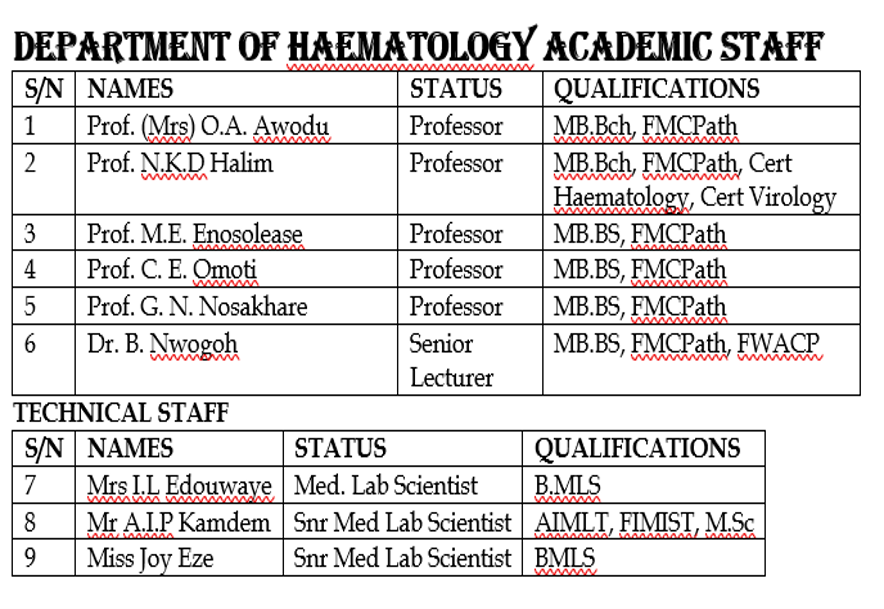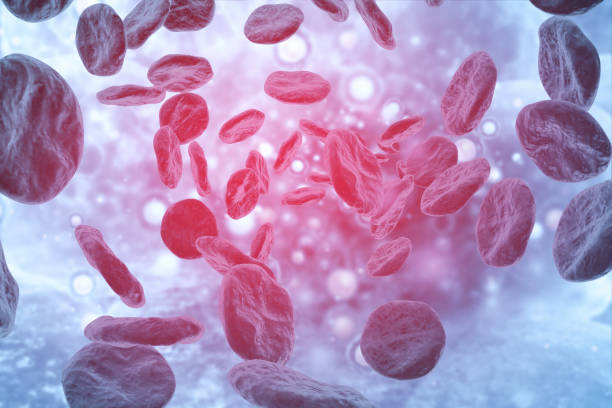
Haematology and Blood Transfusion -Course Contents
HBT 427: Haematology I (1 Unit)
Properties and disease of the red blood cell and blood-forming organs. General introduction. Normal values of some haematological tests in adult Nigerians. Low total white cell count and neutropenia in normal Nigerians and other black people in relation to Caucasians (whites). The normal high eosinophilic count in normal Nigerians. Systematic plan for the diagnosis of anaemias. Indication for bone marrow aspiration and bone macrocytic anaemias. Iron deficiency or lead poisoning. Lack of transfemn. Definition of thalassemia. Anaemia of chronic disorders. Megaloblastic anaemias. Folk acid deficiency, vitamin BJ2, including pernicious anaemia. Myelophthisic anaemias. Aplas-tic anaemia. Points of injury in aplasia. Abnormal haemoglobin. Sickle cell disease and sickle cell trait. Partial protection by sickle cell trait against falciparum malaria in children. Balanced polymorphism and the sickle gene. Other haemoglobin that sickle. Hb-c, Hb-D, Hb-SC. Other rare abnormal haemoglobin— unstable haemoglobin. Methaemoglobinaemia and sulfhaemoglobinemia. Haemolytic anae¬mia due to RBC enzyme deficiencies. Glu-cose-6 phosphate dehydrogenase (G6PD) deficiency Protection of G6PD deficiency against malaria. lyon hypothesis. Pyruvate kinase deficiency and other RBC enzyme deficiencies. Immune haemolytic anaemia due to antibodies (idiopathic, erans syndrome, cold agglutinin antibodies, paroxysma) cold haemoglobinuria (PCH). Drug-induced immune haemolytic anaemia due to defects in RBC membrane (including hereditary) spherocytosis and elliptocytosis. Burr cell anaemia. Spur cell anaemia, micro angiopathic haemolytic anaemia, prosthesis (cardiac) march hae¬moglobinuria. Haemolytic anaemia due to malaria. Inherited protection against malaria by RBC genes. Tropical splenomegaly syndrome. Other causes of splenomegaly hypersplenism. Physiological adaptation to anemia, 2,3 DPG. Factors affecting oxygen dissociation curve. The polycythemia – definition by RBC mass (vol). Primary and secondary. Quality assurance.
HBT 517: Haematology II (1 Unit); Blood Groups, Blood Banking, Blood Transfusion and Transfusion Reactions (lUnit)
The topics include ABO red cell groups, blood grouping (typing) and crossmatch, the ABH antigens in disease, the I and II antigens and antibodies. The rhesus (RH) system. Direct and indirect Coomb’s (an-tiglobulin) test, other blood groups, including the significance of high percentage of Duffy negative blood group in West Africans. Blood transfusion and transfusion reactions. Haemolytic disease of the newborn. The topics include the paraproteinamias, multiple myeloma and related disease, including waldernStrom’s macroglobulinaemia. leukopenia, leukemoid reactions – myeloid, lymphocytic eosinophilic, marked eosinophilia, tropical eosinophilia, hypereosinophilic syndromes. Diagnostic approach to lym-phadenopathy, causes of lymphadenopa-thy, investigation of lymphadenopathy, mycosis fungoides, infections monoculeosis. Acute leukaemias, general consideration, pathogenisis, incidence, aetiology and classification. Acute leukaemias, chloroma. Chronic leukaemias, chloroma. Chronic leukamias, chronic granulocytic leukamia, chronic lymphocytic leukaemia, non-Hodgkin’s lyphoma. Burkitt’s lymphoma – African and American types. Role of Epstein-Burr virus and malaria in Burkitt’s lymphoma. Hodgkin’s disease. Acquired immune deficiency syndrome.
HBT 527: Haematology III (1 unit) – (Bleeding Disorders and Thrombosis) (lUnit)
The topics include disorders of haemostasis to stop bleeding after injury to a blood vessel. Platelet adhesion and aggregation. Bleeding disorders due to platelets. Thrombocytopenias including idiopathic thrombocytopenic purpura (ITP). Tests for platelet function. Acquired and congenital defects of platelet function inhibitors of platelet function. Coagulation disorders – including the haemophilias and Von Willebrand disease, other coagulation defects. Coagulation tests including prothrombin time, activated partial thrombo-plastin time, thrombin time. Defibrination syndromes: dissemination intravascular coagulation (DIC) and primary (orpathological) fibrinolysis. Thrombosis and hypercoagubility. Anticoagulant therapy – hoparin and oral anticoagulants. Inhibitors and potentiators of oral anticoagulants.
HBT518: Practicals
Blood film preparation principles and method of staining. Full blood count – PCV, WBC, platelets. Hb electrophoresis serological tests – blood group and cross match crumbs test Identification of blood films and bone marrow films. Coagulation test – prothrombin time, APTT and correction test.

Recent Comments